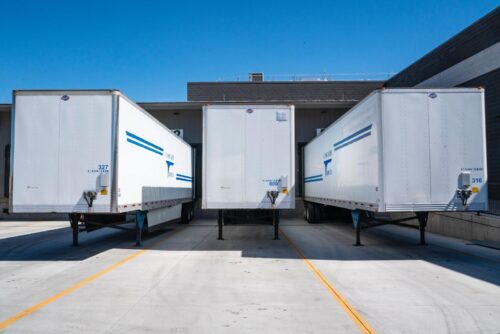Hybrid Fulfillment: Definition and Types

In the ever-changing world of logistics and order fulfillment, businesses are constantly seeking innovative ways to efficiently meet their customers’ needs. Well, here’s a game-changer for you: Hybrid Fulfillment. This approach allows you to combine and integrate different fulfillment methods, unleashing a world of possibilities for optimizing your fulfillment process.
Defining Hybrid Fulfillment and Business Growth
Hybrid fulfillment means a strategic approach to order fulfillment that combines multiple methods and logistics models to meet customer demands efficiently. It’s a versatile and adaptable way of handling orders, ensuring that businesses can provide the best possible service to their customers.
Hybrid fulfillment is all about customizing your fulfillment solution by blending various methods. It’s not about sticking to one model; it’s about harnessing the strengths of multiple methods to meet the demands of today’s customers.
Hybrid fulfillment gives you the upper hand with its flexibility. You can seamlessly switch between different methods as customer demands and market trends evolve. This adaptability ensures you consistently meet customer expectations.
To unlock the potential of hybrid fulfillment, assess your specific needs. Understand customer experiences and inventory requirements to determine which methods to integrate. Invest in advanced inventory management systems and order processing software. These tools streamline the coordination of multiple fulfillment methods, making your operations more efficient.
Regularly monitor your fulfillment operations and collect data. This practice helps you make informed decisions, identify improvement areas, and continually enhance efficiency.
Types of Hybrid Fulfillment

Order fulfillment in today’s business landscape is about finding the right strategy to meet customer demands effectively. Hybrid fulfillment, known for its adaptability and versatility, offers several types that address different order processing and delivery aspects.
The In-House Fulfillment Model
In-house fulfillment is a hybrid approach where you fully control your order fulfillment operations, from warehousing to shipping. This model empowers you with complete oversight and is ideal for companies striving to maintain quality standards and direct inventory management.
Key Features
- Complete Control: You have a hands-on approach, ensuring precision in order fulfillment.
- Quality Control: You can implement and maintain stringent quality control measures with in-house fulfillment, ensuring the highest product quality.
- Custom Fulfillment Solutions: This method enables you to tailor your fulfillment processes to meet your specific requirements and align with customer experience.
The Third-Party Fulfillment Model
The third-party fulfillment model involves collaborating with external fulfillment providers to manage specific aspects of your order fulfillment process. This model offers scalability and expertise in areas where your business may need more specialization.
Key Features
- Scalability: You can tap into the resources and infrastructure of third-party providers to handle increased order volumes, particularly during peak seasons.
- Outsourcing Fulfillment: This approach allows you to outsource logistics and operational aspects of order processing, reducing the workload on your in-house teams.
- Flexible Fulfillment: Third-party fulfillment provides the flexibility to adapt to changing market conditions without significant investments in infrastructure.
The Drop Shipping Model
Drop Shipping is a hybrid fulfillment model that involves collaborating with suppliers to ship products directly to your customers. This approach offers significant benefits, including reduced inventory storage costs and providing a more extensive product range.
Key Features
- Reduced Inventory Costs: By adopting drop shipping, you minimize the need to store large quantities of inventory, resulting in cost savings on storage expenses.
- Product Variety: Your business can diversify its product offerings by partnering with multiple suppliers, providing customers with a broader selection.
- Lower Shipping Costs: Since products are shipped directly from suppliers, shipping costs can be lower, benefiting your business and customers.
The Self-Fulfilling Model
The self-fulfillment model allows your business to take charge of order processing, warehousing, and shipping, all while maintaining complete control over the fulfillment process. This approach ensures a personalized and efficient delivery process.
Key Features
- Direct-to-Customer: Opting for a self-fulfillment strategy enables your business to ship products directly to customers, ensuring a personalized and efficient delivery process.
- Meeting Consumer Expectations: To fulfill orders in-house, all aspects of your business can consistently meet and exceed consumer expectations.
- Stress-Free Approach: Businesses that prefer self-fulfillment can maintain a stress-free approach to fulfillment, knowing they have absolute control over their supply chain.
Planning a Hybrid Fulfillment Solution

Hybrid fulfillment combines different order fulfillment methods. Let’s take a closer look at the pros and cons of outsourcing fulfillment.
Advantages of Hybrid Fulfillment
- Diverse Fulfillment Methods: With a hybrid fulfillment model, you can blend in-house fulfillment strategy, third-party provider, and more, giving you flexibility and diversity.
- Cost Optimization: You can choose the most cost-effective fulfillment strategy for each order, reducing expenses related to shipping, storage, and inventory management.
- Meeting Customer Expectations: Hybrid fulfillment offers various shipping options, ensuring that your customers receive orders the way they want, leading to higher satisfaction.
- Building a Resilient Supply Chain: The flexibility of hybrid fulfillment means your supply chain is more resilient, allowing you to adapt quickly to changes in demand or unexpected challenges.
- Reducing Operational Stress: By diversifying fulfillment methods, you can simplify complex logistics, freeing you up to focus on growth strategies.
- Efficient Regional Fulfillment: Regional order fulfillment becomes more efficient, catering to the unique demands of different areas, resulting in faster deliveries and happier customers.
Disadvantages of Hybrid Fulfillment
While there are many pros, there are also other things to consider.
- Complex Logistics: Coordinating multiple fulfillment methods can be complex, requiring efficient inventory management and logistics operations.
- Integration Challenges: Integrating various fulfillment models may require significant investments in technology and infrastructure.
- Higher Initial Costs: Implementing a hybrid fulfillment strategy might involve higher initial costs than using a single method.
- Quality Control: Maintaining consistent quality control across different fulfillment methods can be challenging, potentially affecting the overall customer experience.
- Inventory Management: Effective inventory management becomes crucial to avoid issues like overstocking or stockouts.
- Overcoming Implementation Hurdles: Transitioning to a hybrid fulfillment model may require more employee support and comprehensive training.
Determining if Hybrid Fulfillment Solutions Complement Your Business Goals
Integrating a hybrid fulfillment strategy into your business requires careful consideration of several key factors. Firstly, assessing your growth objectives is essential. Are you looking to expand your e-commerce fulfillment operations both domestically and internationally? If so, a hybrid approach can provide the flexibility needed to scale efficiently.
Next, analyze your product range. Are you dealing with various products, some of which may benefit from in-house storage while others are better suited for dropshipping or third-party logistics? Understanding your product mix is crucial in determining the role of hybrid fulfillment.
Additionally, it’s crucial to evaluate your budget and resources. Can you afford the initial investment required for in-house storage and logistics? Are you willing to manage your inventory and deal with warehousing complexities? Balancing these considerations with a hybrid approach’s potential cost savings and operational efficiency is essential.
Lastly, consider customer expectations. Are your customers demanding faster shipping times and a wider product selection? A hybrid fulfillment solution can help meet these expectations by combining the strengths of various fulfillment methods. Ultimately, embracing hybrid fulfillment hinges on aligning these factors with your business goals and customer needs.
Choosing a 3PL Logistics Partner
Several crucial factors should guide your decision when selecting a third-party logistics (3PL) partner. Versatility is key; look for a partner who can adapt to your changing needs and handle various types of products.
Evaluate their technological capabilities, as advanced systems can streamline order processing and provide real-time visibility into your supply chain. Consider their geographic reach; a partner with a global presence can help expand your market reach and navigate international complexities. Excellent customer service is non-negotiable, as it ensures smooth communication and issue resolution.
Additionally, assess their fleet access, as it can impact the efficiency of transportation and delivery. By prioritizing these aspects, you can secure a 3PL partner that aligns with your business’s goals and helps you achieve logistics excellence.
Frequently Asked Questions
This section will address some frequently asked questions related to hybrid fulfillment, order processing, and logistics.
What is hybrid fulfillment?
Hybrid fulfillment combines various order fulfillment methods, such as in-house and third-party logistics, to optimize efficiency and meet customer demands effectively.
What are the 4 types of fulfillment?
The four types of fulfillment are in-house fulfillment strategy, third-party logistics (3PL), drop shipping, and hybrid fulfillment, each with distinct approaches to order processing and shipping.
What is a hybrid fulfillment approach for cross-border e-commerce?
A hybrid fulfillment approach for cross-border e-commerce combines local and international fulfillment centers to provide cost-effective, efficient, and timely order delivery across borders.
What is hybrid dropshipping?
Hybrid dropshipping blends elements of traditional dropshipping with in-house inventory management, offering flexibility and cost control while maintaining product availability and customer satisfaction.
Conclusion
Hybrid fulfillment offers a range of models, each with unique advantages and applications. To determine the most suitable approach, carefully evaluate your needs, customer expectations, and market conditions.
Understanding these types of hybrid fulfillment will enable your company to adapt, grow, and remain competitive in the e-commerce business. By carefully weighing these factors, you can leverage the strengths of hybrid fulfillment while addressing its challenges, creating a fulfillment strategy that propels your business toward growth and success.
